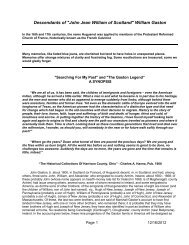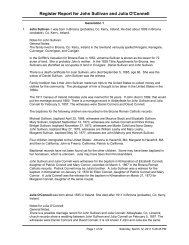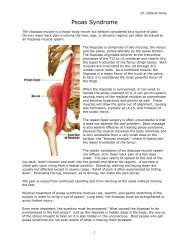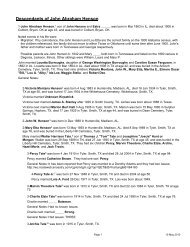Static Ignition Timing - General
Static Ignition Timing - General
Static Ignition Timing - General
You also want an ePaper? Increase the reach of your titles
YUMPU automatically turns print PDFs into web optimized ePapers that Google loves.
Tools Required:<br />
Test Lamp: This is a device made by connecting two wires to a simple automotive light bulb. One wire connects to<br />
the contact tip of the bulb, the other to the metal shell of its base. When the two wires are connected<br />
across a 12 Volt supply the bulb lights to indicate power is present.<br />
Multi-meter: Electrical volt/ohm meter. This is optional and can be used in place of the test lamp to determine when<br />
12 Volts is present.<br />
Wrenches: The distributor will be clamped to the engine block. It will be necessary to loosen the distributor clamp<br />
to rotate the distributor and adjust the timing.<br />
Theory of Operation:<br />
In the discussions that follow, all electrical polarity mentioned is for negative ground cars.<br />
A basic understanding of the coil and its operation is necessary to understand what is to be achieved in static timing. The<br />
figure below shows a simplified schematic of the Kettering ignition system using points and a condenser. In electronic<br />
ignitions an electronic module replaces the points and condenser but serves the same function. Succinctly, when the coil is<br />
supplied battery voltage on its (+) terminal AND the ignition points in the distributor are closed, current flows through the<br />
ignition coil to chassis ground. This creates a magnetic field inside the coil. As the crankshaft in the engine rotates, it turns a<br />
cam inside the distributor (at 1/2 engine speed). The cam in the distributor opens the points and disrupts current flow through<br />
the coil. When the current stops flowing through the coil, its magnetic field collapses and this creates a high voltage spike on<br />
the coil’s high-tension or secondary windings. The high voltage spike is delivered via the rotor, distributor cap, and spark plug<br />
wires to the appropriate spark plug.<br />
For the engine to run efficiently and develop the proper power, the spark must occur at the right time. This is controlled by<br />
adjusting the position at which the cam in the distributor opens the points relative to the position of the crankshaft (the<br />
distributor body position is adjusted so the points open at the correct crankshaft position). Most engines (for reasons beyond<br />
the scope of this document) require the static ignition timing be set so the ignition points open several degrees before the piston<br />
reaches top dead center (BTDC). Setting the static timing is a simple task but care needs to be taken when making these<br />
adjustments that they are being carried out for the correct cylinder at the correct step in the four-cycle process. (Typically this<br />
is with cylinder #1 several degrees BTDC on the end of the compression stroke).<br />
<strong>Ignition</strong> System Schematic (Negative Ground)<br />
<strong>Static</strong><strong>Timing</strong>.doc Page 2 of 6







